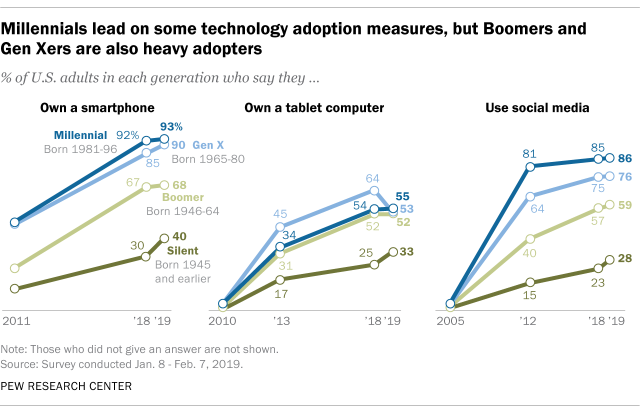Smartphone statistics and tablet usage patterns
As technology advances, so do the behaviors of the users so, for us, keeping up with the latest research and statistics is both a necessity and a delight.
We're aware that we process images 60.000 times faster than texts so we've prepared some infographics for all you data viz aficionados out there. Click to go straight to the infographics.
State of the mobile economy in 2020
Comparing PC/laptops, smartphones and tablets, smartphones are the most commonly used for accessing the internet with 91% of internet users saying this.
The relationship between us and our mobile devices is stronger than ever. If in 2018 we used to spend, on average, 3 hours and 15 minutes a day - that’s 47 days/year - on our mobile devices, during the pandemic these numbers have skyrocketed to screen time reports of over 8 hours/ day.
All numbers point to this relationship becoming even tighter. Between 2016 and 2019, the number of smartphone users worldwide increased from 2.5 billion to 3.2 billion and it’s expected to reach 3.8 billion by 2021.
Although it has a milder growth curve, the number of tablet users worldwide is expected to reach 1.28 billion by 2021, amounting to almost 19% of the population.
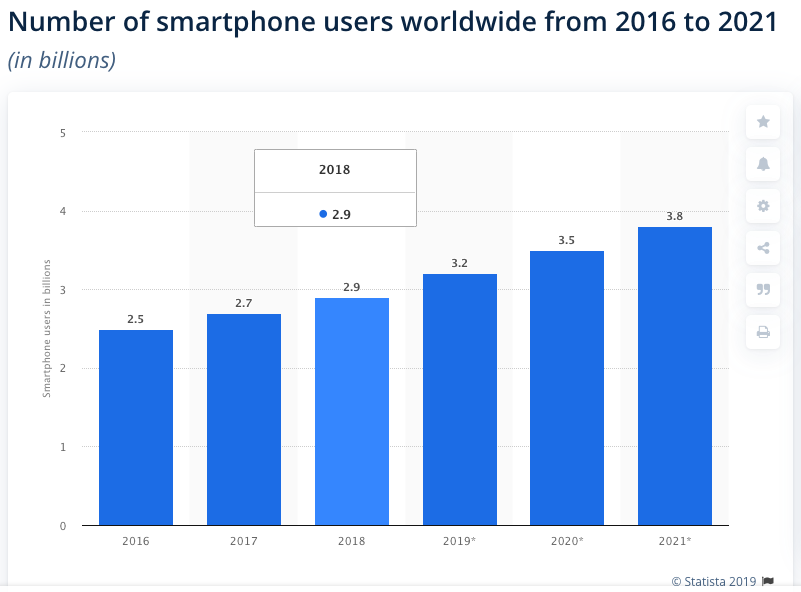
As of July 2020, close to 4.57 billion people were active internet users, accounting for 59% of the total global population. Out of these, 4.17 billion people are unique mobile internet users, according to the same research conducted by Statista.
The fact that we use mobile devices is an understatement. What’s valuable is to understand how people use their smartphones, tablets and the apps they install. Which are the most popular apps in 2020 so far? When and where are people most prone to using their mobile devices? We take a quick look at some statistics and then look at some predictions for the future of the mobile economy.
Smartphone statistics and tablet usage patterns
Where?
Take any random day. Imagine you’re walking home from the supermarket. Look around. Chances are at least 1 person is staring down at a phone, either in the bus stop, in the car that just drove by or on the terrace of that cosy café. It might just as well be you, scrolling while reading this very article :)
With the spread of mobile internet subscriptions, people can use their mobile devices virtually everywhere.
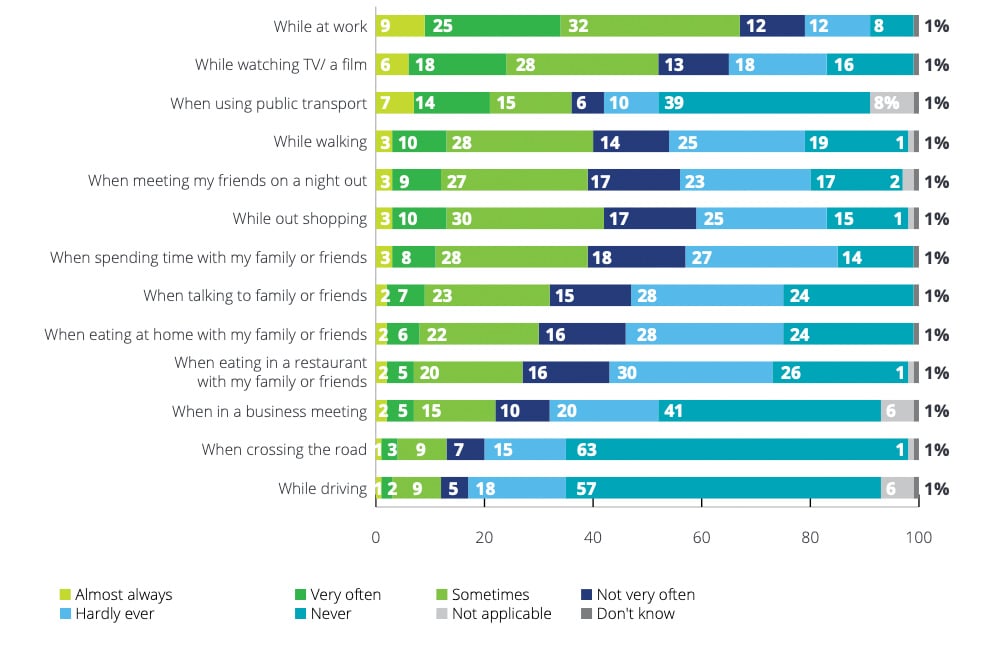
via Deloitte
Research conducted by RescueTime says most people check their phones 58 times a day, 30 of those being during work hours. This is why the impact of smartphones on work productivity is a heavily debated topic nowadays.
The top 4 reasons why employees use their smartphones at work are: messaging, checking the weather, reading the news and playing games.
At home, at work, on the street, while driving, during dinner, in the lunch break. The smartphone has become so ubiquitous that it’s easier to just look online for places where people aren’t allowed to use mobile devices, rather than where they are. It makes for a shorter list. Apart from the Sistine Chapel and digital detox resorts, there’s even a small town in the USA where it’s illegal to use mobile phones.
While smartphones are used almost everywhere outdoors, tablets are preferred for home use: on the couch, at the dining table and in the bedroom. Only 12% of people say they use their tablets outdoors.
Probably due to their size, when using tablets, people generally lean on their backs, slump over the tablet while it rests on their laps or just lie on their sides. These postures are significantly associated with musculoskeletal symptoms of pain in the neck and shoulders so a new term has been coined. It’s called “iPad neck”. If you're reading this on a mobile device, remember to sit straight :)
Why?
As smartphones can easily fit the pocket or the purse of their user, they became a substitute for several other devices and objects such as MP3 Player, wristwatch, satellite navigation device, photo camera, newspaper, book, magazine, not to mention it’s the most widely used method of staying informed.
Top 10 activities people perform on their mobile devices
One recent study showed that people don’t use mobile phones for their intended purpose: to make and receive phone calls. Calling didn’t even make the top 10 reasons why people use smartphones. The main activities are:
- Texting (88%)
- Email (70%)
- Facebook (62%)
- Camera (61%)
- Reading news (58%)
- Online shopping (56%)
- Checking the weather (54%)
- WhatsApp (51%)
- Banking (45%)
- Watching videos on YouTube (42%)
The rise of m-Commerce
M-Commerce is on the rise, especially during the pandemic. The main drivers for growth of global mobile shopping are the increased ownership of mobile devices, the increased number of Internet users and the high adoption of mobile payment methods.
Although there used to be lower conversion rates due to the frustration caused by having to go through the entire checkout process on a small screen, things are changing. In 2019, in the US, m-commerce volume was $128.4 billion and it’s estimated to more than triple to $418.9 billion through 2024.
Tablets are also massively contributing to the success of m-commerce. Business Insider Intelligence expects an increase to $69 billion by 2024 - from $29 billion in 2019.
The adoption of m-commerce is different from generation to generation but there is huge potential for businesses to address each segment according to preferences. Generation-wise, the percentage of users who regularly shop online using smartphones are:
- 79% of Millennials;
- 70% of Gen Z;
- 54% of Generation X;
- 27% of Baby Boomers.
The rise of mobile banking and mobile payments
Mobile banking apps are expected to generate a revenue of $581.9 billion from downloads in 2020. It’s calculated that in 2018 alone there have been 6152 mobile banking app installations per second. Research conducted by Deloitte showed that the top 4 most performed activities related to mobile money are:
- Check bank balances (49%);
- Online bank transactions (42%);
- Transfer money to another individual in your country (27%);
- Transfer money to another individual in a different country (6%).
The total value of payments made using mobile devices is also predicted to grow with new and attractive players entering the banking market with mobile-first solutions - e.g. Revolut, N26.
Less obvious reasons to use your smartphone
A funny list of reasons why we use our smartphones was compiled recently. Some respondents stated they used their mobiles to perform the following unusual - yet credible - actions.
I confess to number 7.
- Took picture of a spot on my back
- Recorded a conversation as evidence at work.
- Used the phone as a bottle opener
- Used it as a hammer
- Used it as a bed warmer
- Used it as a back scratcher
- Used it as a paperweight
- Used the reflection to spy on people behind you
- Used it as a nutcracker
- Used it as a chopping board.
How?
Screen time is the time spent using electronic devices such as TVs, laptops, computers, smartphones and tablets.
Regular smartphone users keep their devices close by the entire day. Not having it close by causes people to feel anxious. 80% of people aged 18-24 say they sleep with their mobile phones next to them, checking them even in the middle of the night.
This behaviour is conducive to having smartphone addiction.
At home, what studies coin as “me-time”, comes down to using mobile devices to watch movies, play games, shopping and socialising, which includes Facebook, Twitter, Instagram and all other apps used for sharing news and interests or chatting with friends (SMS and Messenger are among the most important).
A complete ranking of foremost activities by average screen time is below:
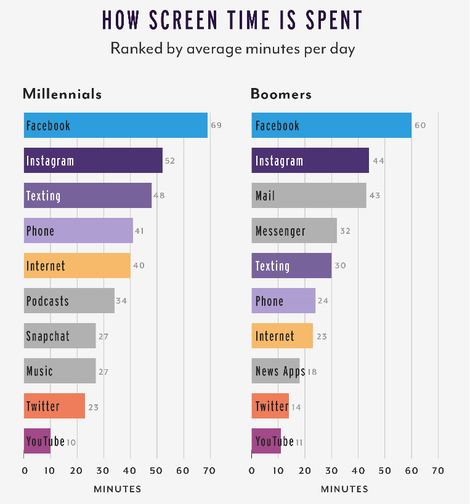
via Provisionliving.com
Who?
Who are the smartphone users? And how do they keep up with the latest trends in mobile models?
Gadgets are objects that we’d be tempted to think about more in relation to men but, as it so happens, women spend 4% - 6% more time on mobile devices than do men.
To what age is concerned, Millennials take the lead when it comes to smartphone ownership. 9 in 10 Millennials own smartphones, closely followed by Generation X with 90% and Baby Boomers with 68%.
Generation Z is the first true digital native generation. 78% of Gen Z say the mobile is the most important device they use to access the internet. 64% of Gen Z smartphone users say they are always connected.
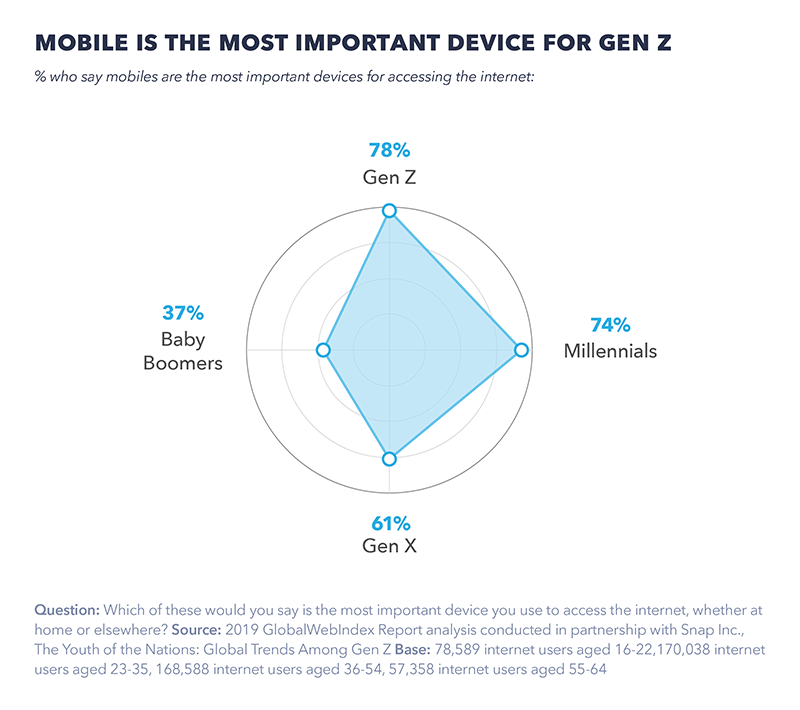
via Snapchat
Regardless of age and gender, some have adopted new technologies more easily than others, as it appears that "digital immigrants” encounter problems when trying to use technology.
A digital immigrant is a term used to refer to a person who was raised before the digital age - usually those born before 1985. One cause can be that designers haven’t thought about providing guidelines to using smartphones the way washing machines or TV manufacturers would have done decades ago. Hence, the painful trouble people still go through while timidly swiping their touch screens.
App usage patterns
Insane statistics about smartphone usage:
- There are more people who own a smartphone than there are toilets on a global scale;
- We touch our phones 2617 times a day, on average;
- 75% of smartphone users admit that they have texted while driving at least one time;
- 71% of smartphone owners sleep with or next to their mobile phone on a typical night.
Which apps lead the charts?
But what are we doing on our phones that keeps us engaged for hours on end? The answer is pretty straightforward: we’re using apps. Mobile phone usage statistics say that 90% of mobile time is spent on apps.
There are 2.2 million apps available on the App Store and 2.8 million more on the Google Play Store, so there’s literally something “in store” for all of us.
Revenue from mobile apps is expected to reach a figure of $189 billion by 2020. This figure is very much reachable when we take into account the fact that an average person uses 30 apps per month, and 21% of millennials check their apps more than 50 times a day.
In the midst of the pandemic, in April 2020, ZOOM was the most downloaded non-gaming app in both App Store and Google Play. It had 131 million installs, a 60x growth compared to 2019.
TikTok is the first runner up, with 107 million downloads in April 2020, registering a 2.5x growth in a year. The following 3 most downloaded non-gaming apps include Facebook, Whatsapp and Instagram.
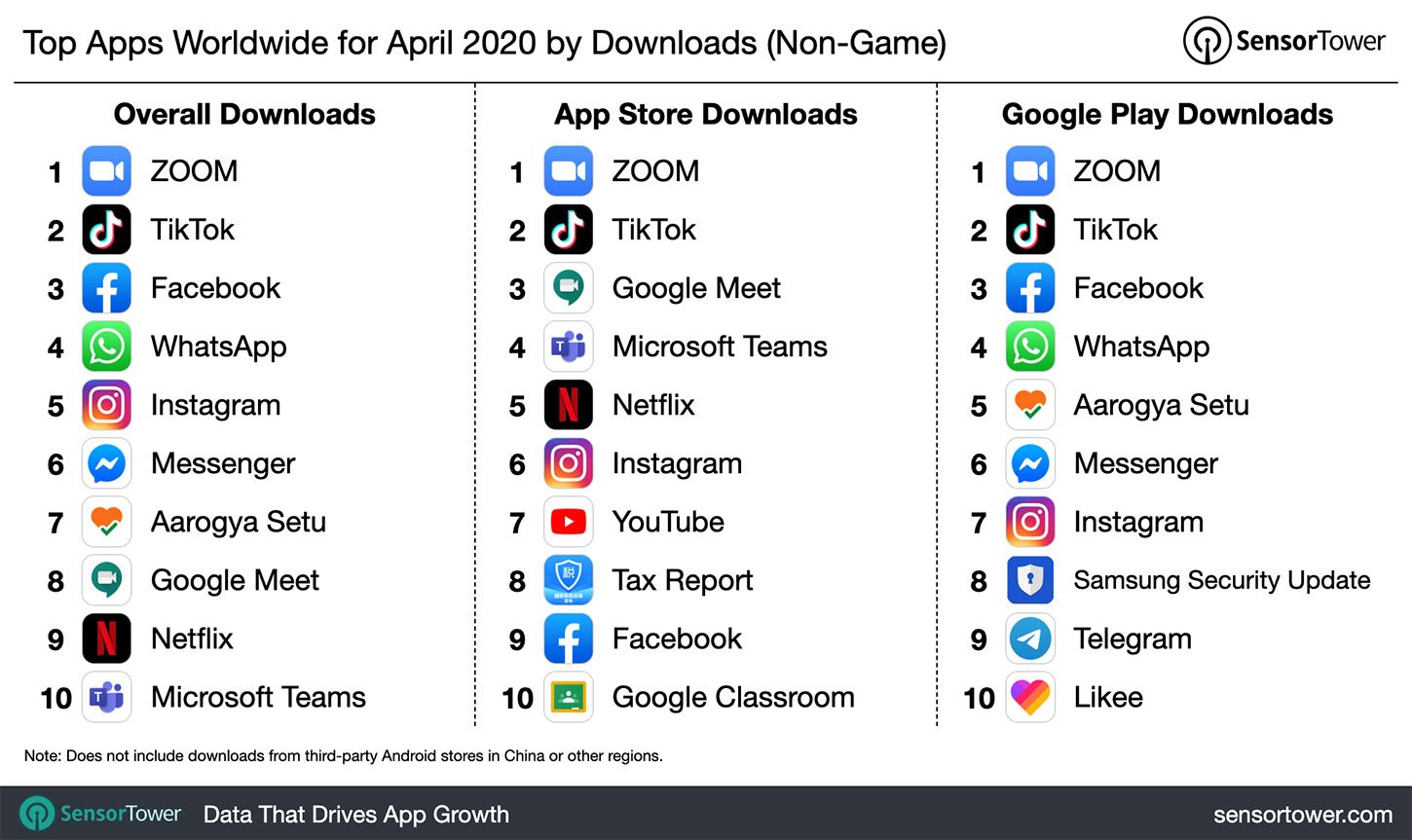
To what gaming apps are concerned, ASMR Slicing from Crazy Labs was the most downloaded mobile game worldwide in May 2020 with 36.5 million installs.
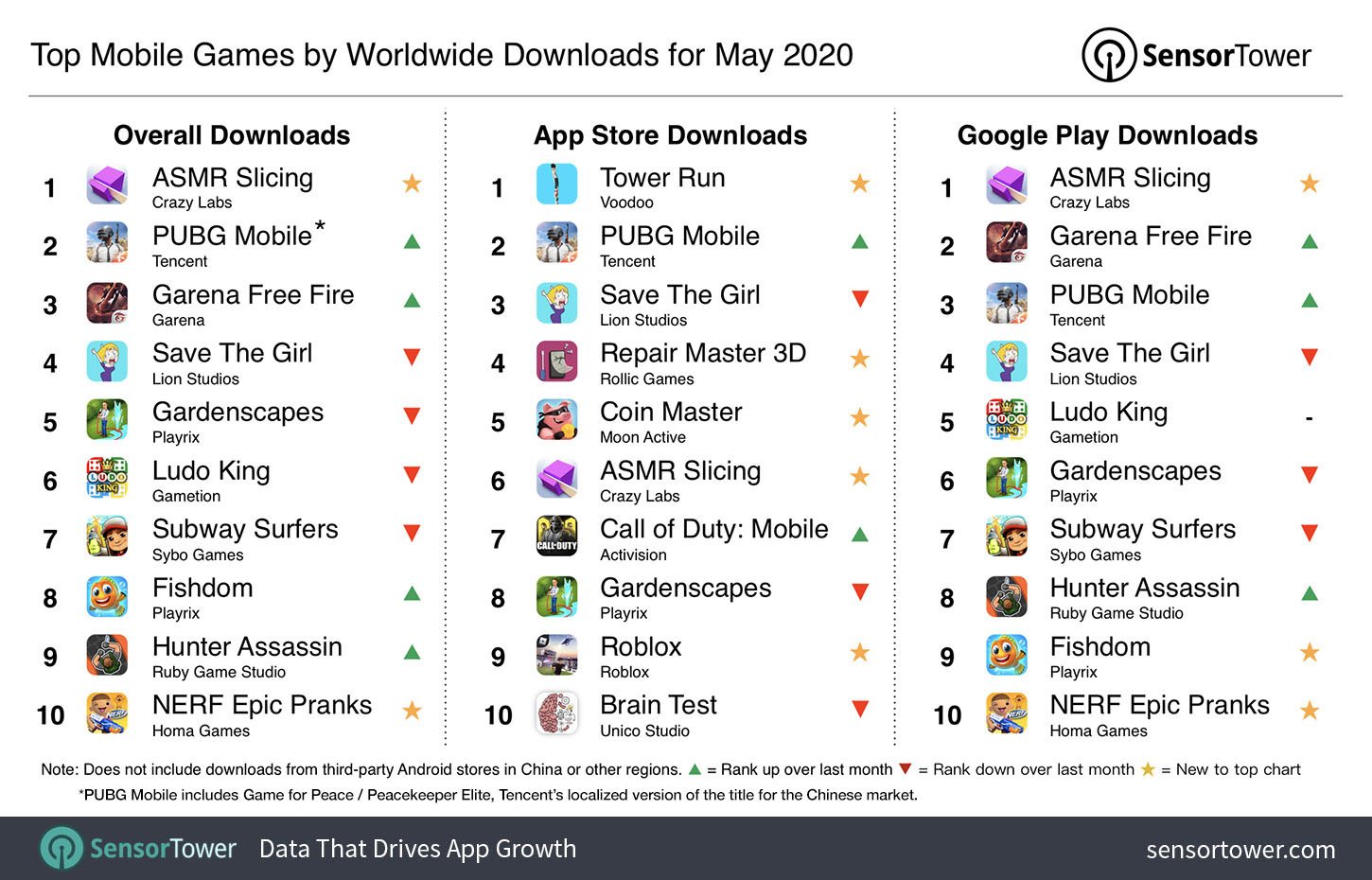
Let’s take a closer look at when people use these apps and how they interfere with their daily schedules.
When?
The pandemic changed not only our lifestyles but also our behaviour regarding when we typically use our devices. All signs point to increased connectivity regardless of the time of day.
A study conducted in March 2020 showed that, during quarantine, there was a spike in CTV and tablet usage between the hours of 10pm and 6am. This indicates that content consumption became more fluid throughout the entire day.
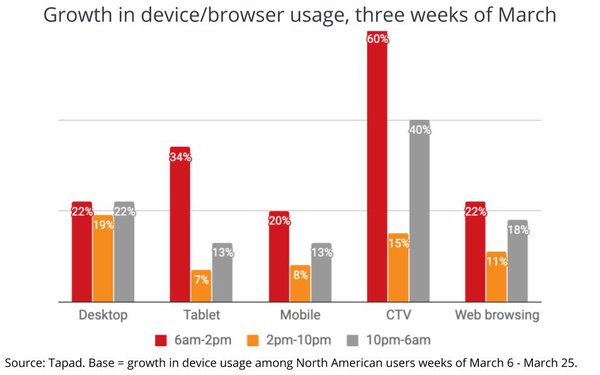
A growing part of the population admits to sleeping with their devices nearby so checking the phone is the last thing they do before falling asleep and the first thing they do when they wake up. This is particularly true for 66% of Millennials aged 18 to 24.
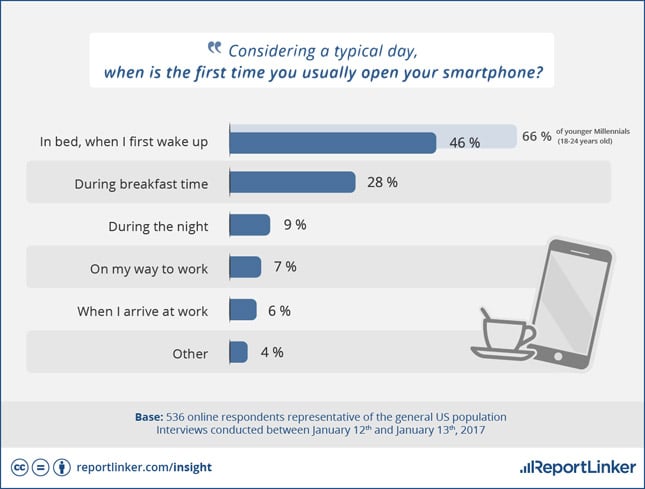
The fact that we’re growing used to being connected 100% of the time, in every location possible can lead to various mental health issues, associated with the overuse of mobile phones, one of which is called nomophobia.
Nomophobia (short for “no mobile phobia”) is the fear of not having a mobile phone. It refers to the anxiety we feel when we don’t have a working phone (either by losing it or not having coverage, battery or credit).
Conclusion
Not too long ago it was inconceivable to think we’d be able to have access to such smart devices at our convenience. It’s been an insanely fast digital transformation. Now, the pulse of upcoming technology advances is at an all time high, consumers and technology experts both wondering what will happen next.
Here are some predictions:
- 3.7 billion people (72.6% of internet users) will access the web solely via their smartphones by 2025,
- 5G will fuel future innovation and economic growth, allowing new digital services to bloom. Many countries have already launched 5G, but commercial adoption of 5G services is expected to happen from now on.
- Increased interactions with voice assistants. Our mobile devices will have enhanced digital assistants, powered by NLP and AI integrations.
- Mobile Health App market will grow by 44.9%, from its $18.3 billion historical market size in 2019.
How all this will affect usage patterns, nobody knows. Apps will probably cover all human needs. This will lead to even more time spent online, browsing, gaming, social networking and entertaining ourselves. In the end, we might see today’s proportions fully reversed.
Infographics
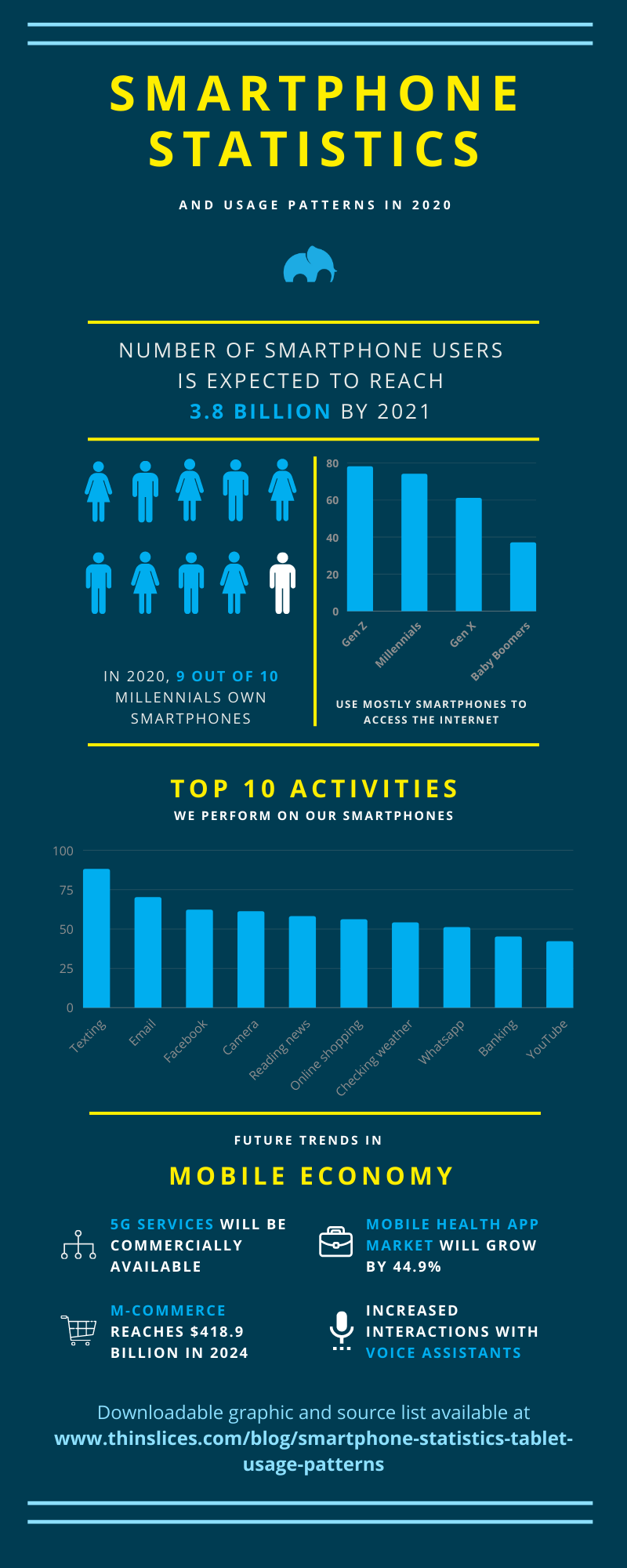
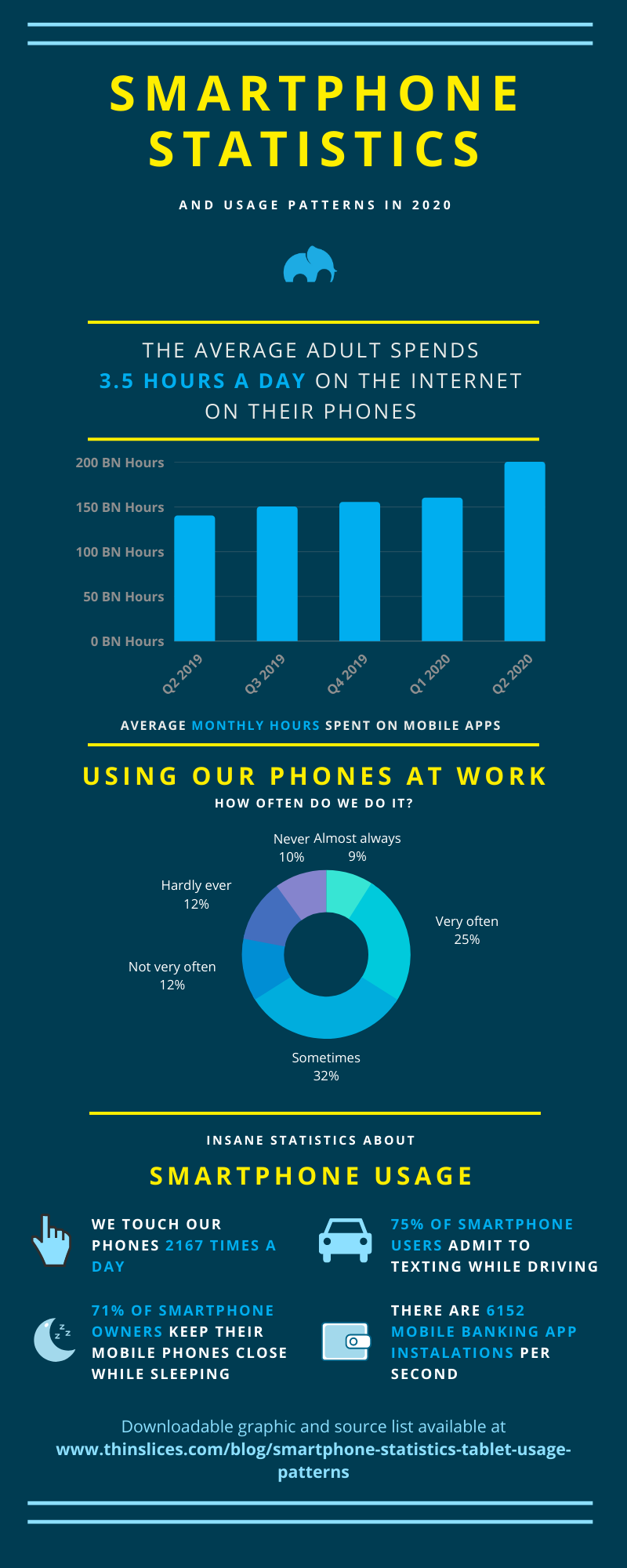
Photo by Dimitri Karastelev from Unsplash
Editor's note: this article was first published in 2014 and has been updated on August 18, 2020.
